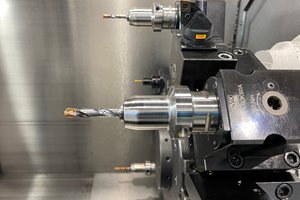With the ability to remove large amounts of material at increased cutting speeds while retaining tool life, about 80 percent of inserts used in machining today are coated carbide grades, according to cutting tool manufacturer Seco Tools (Troy, Michigan). To improve the performance of coated products, cutting tool manufacturers take such approaches as making fine adjustments to the chemistry in the coating furnaces, exercising more careful structural control of the individual coating layer, and polishing edges after the coating process. All are designed to improve quality, increase productivity or reduce costs. Although most of these developments are incremental, Seco’s Duratomic coating methodology is a more significant advancement, the company says.
The company coined the term “Duratomic” as a reference to the durability of the resulting product and the fact that performance gains depend on factors that are manipulated at the atomic level. This formulation shows less crater wear, less cutting edge deformation and longer tool life than conventional Al2O3 coatings, the company says. Additional benefits are said to include increased flank wear resistance and improved speed capability compared to both conventional Al2O3 and titanium carbonitride (TiCN) coatings produced by MTCVD.
Applied via chemical vapor deposition (CVD), Duratomic began as a standard Al2O3 formulation. However, through careful control of what is termed the “nucleation layer” between an underlying titanium carbide (TiC) layer and the Al2O3, the company obtained what it says is a unique “texture,” or crystallographic orientation. An analogy is perhaps the best way to describe this texture. Certain materials have anisotropic properties—that is, properties differ according to direction. One such material, wood, provides an example. A log can be split easily if the ax is driven parallel to the grain of the wood, but if the log were tilted a few degrees, splitting it would be much more difficult.
Similarly, Al2O3 is tougher and harder in some crystallographic directions than others. The Duratomic process brings to bear a favorable crystallographic direction via careful chemistry and thermodynamic control. This provides an oxide coating that runs cooler and is both 15 percent tougher and 10 percent harder than conventional Al2O3. Running 60°C (more than 9 percent) cooler than conventional Al2O3 in typical applications substantially reduces the tendency for the insert to crater, the company says. Increased hardness translates directly to increased abrasion resistance, and therefore, tool life.
Other benefits cited by the company stem from the coating’s structure, which is composed of two functional parts. An inner TiCN base layer is responsible for wear resistance and adhesion, while a top layer of Al2O3 acts as effective thermal barrier to permit higher cutting speeds.
However, the coating isn’t the only important factor in an insert grade’s performance. To achieve the desired characteristics, the insert’s substrate must provide proper support for the coating to prevent deformation and chipping. According to Seco, delivering an insert grade that can run faster and longer in a variety of applications depends on the combination of its substrate and coating as well as fine-tuning within the Duratomic range.
The first grade to incorporate Duratomic technology, TP2500, features a substrate that is tailored to be an ideal partner for the coating. Designed for general turning of steels, the grade’s substrate features a specialized cobalt-enriched zone. Cobalt enrichment refers to the process in which cobalt is taken from the core of the substrate and moved to the surface, further increasing the toughness and chipping resistance of the cutting edge. Initial testing revealed productivity gains of 100 percent and tool life improvement of 400 percent in certain applications, the company says.
Unlike TP2500, which is suited for a wide application range, Seco’s newest turning grade is more specialized. Grade TP0500 is designed for improved wear resistance in high-temperature, high speed steel machining applications that require quick removal of a large amount of material. These include machining large components for the power generation or high speed, high-productivity applications in the automotive sector. According to the company, TP0500 provides users with a single, reliable grade for such jobs, simplifying inventory and reducing tool change-over.


















.png;maxWidth=300;quality=90)













